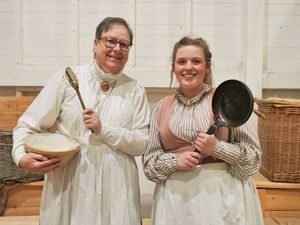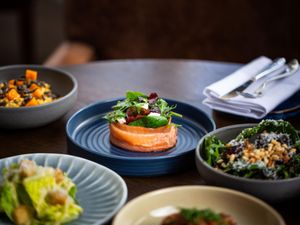Back in time for 19th century grub at Blists Hill Victorian Town
Love will soon be in the air with Valentine’s Day, and as the old saying goes, the way to many of our hearts is through our stomachs.

Restaurants will be full to the brim as Cupid’s arrow flies on February 14, and many an ambitious Casanova will be attempting to prepare their own seductive feast for their loved one.
Yet, when it comes to food, there’s more to this February than Valentine’s Day, with one of our region’s most beloved attractions set to take us all for a five-course session in gastronomic history.
Set to take place at Blists Hill Victorian Town, Ironbridge, from February 15-23, Victorian Food Week will see the treasured family-fun site immersed in the joy of 19th century cuisine. Attendees are promised a bit of half-term fun with a difference, with a variety of activities to get stuck into.
However, the experience is also set to be a very educational one, and a fascinating insight into a fun and important slice of history’s proverbial cake. As Kyla Hislop, Interpretation Curator at Ironbridge Gorge Museums explains, there were a number of differences between Victorian cuisine and what we find on our plates today. “One of the main differences is that food was seasonal,” she said. “Whilst the upper classes could afford to eat more exotically on fruits and other foods imported from warmer climates, the rest of Victorian Britain was limited to what could be grown on home soil.
“The working-class diet, in particular, was very plain, consisting mainly of bread and potatoes. Not only were these things cheap and readily available all year round, they took little effort to prepare which made them convenient in households where the wife or mother also worked and had less time for cooking, or where there were many children to care for with a very small budget.
“The Victorians also didn’t have the same level of knowledge and education about nutrition as we do today, but they did understand that there were benefits to eating meat and its importance for remaining healthy when carrying out heavy manual jobs. Meals therefore typically consisted of a meat – often pork as working-class families tended to keep a pig – alongside your potatoes and bread, and with another vegetable if you could afford it.”
As Kyla relates, the growth of the Industrial Revolution also led to the growth of the food industry in the area. “Histories of Shropshire agriculture are often dwarfed by those of other industries – mining, ironworking, clay mining, and so on – but we know from the existence of surviving mid-Victorian farmsteads that there were local farms to supply towns in the East Shropshire Coalfield with meat, some dairy, eggs, potatoes and grain; all of the staples of the Victorian diet,” she said. “Residents in towns similar to Blists Hill Victorian Town would have purchased all of these ingredients from their local butchers and greengrocers.

“The demands of industry during the Victorian era meant fewer people had the time to make their own bread, so there was also a reliance on bakers during this time. Bought bread did have a terrible reputation, however, for being made from flour bulked out with chalk or plaster and in unhygienic working conditions. But nevertheless, every town in Shropshire would have had a baker. And by 1900, bakery standards rose, and the industry was generally well regarded.
“Food wasn’t all boring for the working class though! The development of steam trawlers to catch an abundance of fresh fish in the North Atlantic and steam railways to transport them across the UK, meant that in the 19th century fish and chip shops were a common sight even in small industrial towns. A portion of fish and chips would only set you back as little as two or three pence (about £1 today) and so was an affordable meal for the working class.”
The more things change, the more they stay the same, and as Kyla relates, family evening meals and the weekly event of Sunday Lunch were just as precious to the Victorians as they are to us today. “For the upper classes, meals were for socialising and were even a way of showing off one’s wealth by serving exciting and novel cuisine from faraway lands,” said Kyla. “Formal dining was also an occasion to demonstrate good table manners and other etiquette for anyone who sought social status. For the middle and lower classes, the evening meal was typically the only time families could come together after a long workday. Sunday lunch was the rare opportunity for family gatherings, as it was often the only day everyone had off.”
As our palates and tastes have grown, many Victorian dishes have of course disappeared from today’s menus. Yet if Kyla could bring one 19th century staple back to its former popularity, for her there is a clear choice.
“Lemon posset,” she said. “It’s not that this delightfully refreshing dessert has completely disappeared from British menus, but it is getting more and more difficult to order, and fewer people are making it at home – despite it being possible to make with just three ingredients: cream, sugar, and lemon juice!
“Eton Mess, Bakewell tarts, Battenberg cake, and other Victorian desserts and sweet treats continue to be readily available in restaurants, tearooms, and the supermarket, but the lemon posset is quickly fading into obscurity. Let's bring it back, says I!”
Blists Hill’s Victorian Food Week promises a delightful array of activities for visitors to enjoy each day. For an additional £2 charge, visitors can take part in a tasting trail around the site and taste some of the more unusual things that Victorians ate. They can try jellied eels, workshop gruel, Camp Coffee, coltsfoot rock and a temperance drink, and will get some sweets as a prize at the end of the trail.
Mrs Clack’s Cooking Demonstration will be held each day at midday. “Feeling confident after last year’s lesson, Constable Jarrett has decided to host a dinner party,” said organisers. “However, his preparations aren’t going to plan, so Mrs Clack needs to step in again to help him out.” There will be free hands-on activities in selected exhibits, and visitors can have a go at helping the town’s Victorians with tasks like sausage making and pie raising, butter churning and bread shaping.
For another additional £2, at the Victorian printer’s guests can also print a wanted poster for a dastardly baker who has been replacing flour with other awful things and poisoning people.
Family fun that sounds good enough to eat – we can’t wait to tuck in.
Visit www.ironbridge.org.uk





